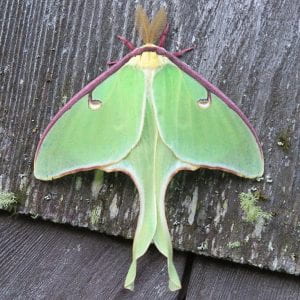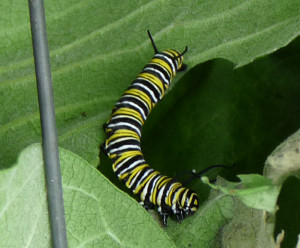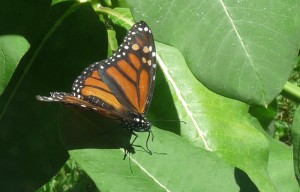(Click here to listen to an audio version of this blog!)
The evolution of moths and butterflies (the “lepidoptera”) is a topic that is constantly being revised as new evidence is found. It was once widely assumed, for example, that the present day lepidoptera arose and coevolved with the flowering plants. The first flowers show up in the fossil record 130 to 150 million years ago (MA), and most previous studies have suggested that moths came into existence around 130 MA and butterflies significantly later (around 56 MA). So, these time frames fit well into the flowering plant/lepidopteran coevolutionary model.
A few years ago (Signs of Spring 3, March 15, 2018) I talked about some findings that radically altered both the evolutionary time frames and also the vision of the ecological roles of these first lepidoptera. Fossilized lepidopteran wing scales collected from sedimentary rocks in Germany were dated back to 200 MA! This is at least 50 million years before the evolution of flowers! With no flowers from which nectar could be gathered, what were these early lepidoptera eating? It was speculated that they drank, like the very early emerging spring butterflies of today, tree saps and other available fluids.
A recent publication, though, has pushed the origin of the lepidoptera back even further.
In a paper published in the Proceedings of the National Academy of Science (November 5, 2019) a research team from the Florida Museum of Natural History used DNA sequences to reconstruct the evolutionary time line of the lepidoptera. Their data traced the origin of the earliest moths back to their divergence from a caddisfly-like, stream dwelling insect 300 MA! These first moths retained the caddisfly, gnawing mouthparts for 60 million years or so and then evolved their distinctive, fluid feeding, tubular mouthparts which they used to feed on the increasingly abundant tree saps until flowers with their nectars evolved.
These early moths, like present day moths, were all nocturnal. Butterflies, though, are active in the day and living in the sunlight has caused them to evolve their rich arrays of colors and visual patterns through which they advertise their toxicities, attract mates or camouflage themselves in their habitats. Butterflies, according to the DNA analysis, diverged from the moths 98 MA (or nearly 40 MA earlier than the previously analyzed fossil record indicated).
Why is this earlier evolution of butterflies significant? It was once widely assumed that butterflies evolved because of intense predation pressure on the nocturnal moths by bats. The previously accepted origin date of the butterflies (56 MA) and the ages of the first bat fossils (50 MA) were close enough to support this hypothesis. Putting the origin of the butterflies into a much more distant past, though, requires re-imagining the selection pressure for their initial emergence, and these new models return to the idea of co-evolutionary changes with flowering plants.
One hundred million years ago moths would have been relying on the wide array of flowering plants for nectar. These flowering plants, though, if they were like present day species, tend to make larger quantities of nectar during the day. Butterflies, the daylight active “moths,” possibly came into being not to avoid predators but, instead, to take advantage of this more abundant food source.
A butterfly with which we are all quite familiar is the monarch. Monarchs are able to do something that is really quite extraordinary: they exclusively eat a highly poisonous plant throughout their larval (caterpillar) stages of development and are able to accumulate these plant poisons into their tissues and give themselves and the adults they turn into, significant protection against a wide range of vertebrate predators!
A team at University of California, Berkeley in a recently published paper in Nature (October 2, 2019) looked into how this remarkable system might have evolved.
They found that only three mutations were needed to develop resistance to milkweed’s cardiac glycoside poisons and to efficiently package these toxins into the butterfly’s larval and adult tissues. These cardiac glycosides exert their toxic effects by interfering with vital sodium channels on muscle and nerve cells, so it is not surprising that two of these mutated gene loci were involved with the protein structure/shape of these sodium channels.
These genes in various combinations were identified on an array of butterflies and other insect species that live in a variety of associations with milkweed. These genes were also isolated and transferred via CRISPR into fruit flies ultimately generating a fruit fly mutant that could live on previously toxic milkweed.
And, finally, an increasingly popular hobby is raising caterpillars into adult butterflies. I know several people for whom this is a lively avocation. They are also very good at it and have remarkable success ratios of adults from eggs!
In the past, I have tried to raise small invertebrates and vertebrates pursuant to a variety of experimental plans: I tried to raise earthworms (Lumbricus terrestris) to see if different phenotypes (dark pigmented versus light pigmented nightcrawlers) would breed true. I also once tried to raise American toads (formerly Buffo americanus now Anaxyrus americanus) from eggs that I had collected from neighbor’s swimming pool. I hoped to get enough toads so that I could raise selected cohorts on different diets to see if diet affected the nature of the toxins they secrete from their parotoid glands. Anyway, my worm cultures dried up and died (the stench in my lab was awful!) and my four aquaria full of active tadpoles funneled down to a handful and then to just a single tiny toad that, in spite of its luxurious diet of mutant fruit flies (vestigial wings so they couldn’t fly away from him!), also finally expired.
Science marches on!
Anyway, I really respect and admire those gifted individuals who have the knack, the instinct and the attention to detail that enable them to raise the young of any small (or large for that matter) creature.
Monarch butterflies are a very popular species for hand raising projects. A major motivation for culturing monarchs is the addition of the reared cohort of butterflies to the monarch’s diminishing, migratory populations. A recent paper in Biology Letters (April 18, 2020) by a research team at the University of Georgia, though, challenges the efficacy of this practice.
Using very ingenious apparatuses this research team measured the muscle strength of wild caught and lab raised monarchs. They also measured the surface area of their wings and the intensity of their wing pigmentation (an overall index of health and vigor). They found that the lab raised monarchs had weaker muscles, smaller, less elongated wings and paler wing pigmentation. These captive, lab-reared monarchs were functionally different from their wild counterparts.
Previous studies had noted that the rates of recovery of tagged, hand-raised monarchs in their overwintering, Mexican forests were substantially lower than the recovery of tagged, wild monarchs. The conclusion was that a large percentage of the hand-raised butterflies were too weak to successfully accomplish the rigorous southern migration.
Difference between the respective stress matrices affecting the caterpillars and adult butterflies in captivity vs. the wild are thought to be the reason for these observations. Wild caterpillars face a myriad of environmental perils while they feed and grow (including predation by a variety of invertebrate and naïve vertebrate species (those vertebrates that haven’t learned that monarchs are poisonous), and death due to milkweed plant defenses). The caterpillars that survive these selection factors, then, are more vigorous and more fit than the hand-raised cohort who are raised in predator-free and relatively stress-free environments. The researchers, in fact, caution against releasing hand-raised monarchs into the wild for fear of adding weak genotypes to the breeding population. As one of the co-authors of this paper put it, “ …. resources may be better spent on habitat conservation and fighting climate change, rather than rearing armies of monarchs.”





